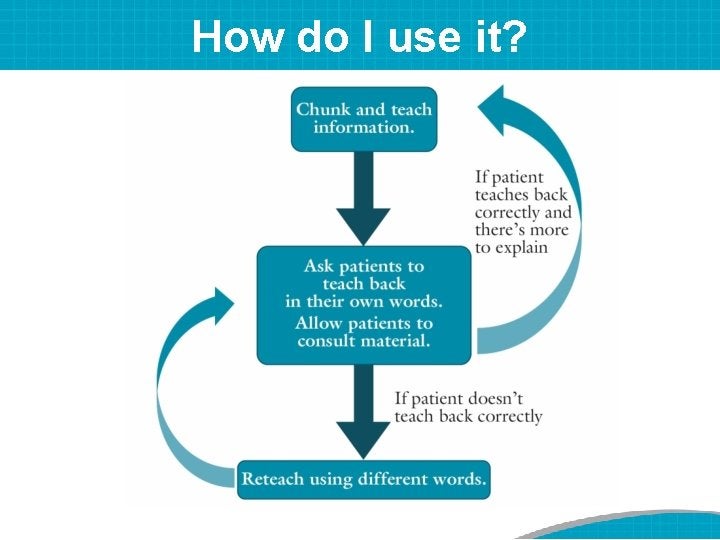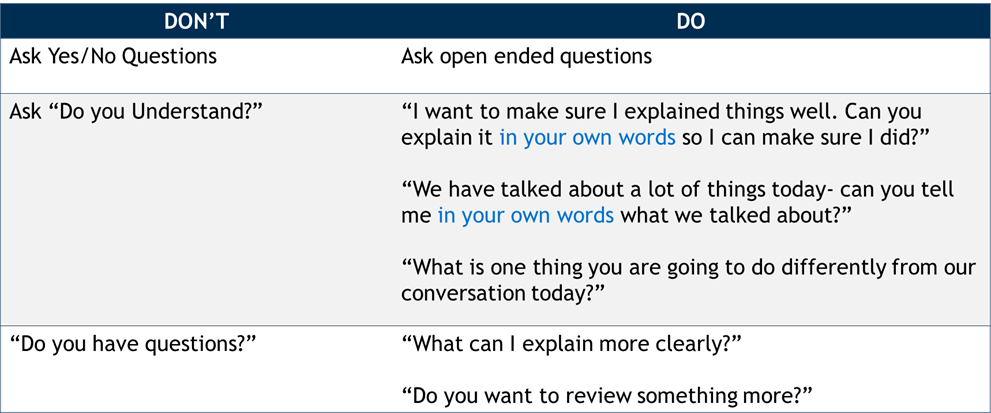
According to the Agency for Healthcare Research and Quality, patients immediately forget 40-80% of the medical information they receive during office visits, and almost half the information they do retain is incorrect. There are specific tools, such as learning assessments, and methods, like chunk and check and teach-back, providers can employ to make sure patients walk away with a solid and core understanding of health information. These tools improve patient understanding and adherence, decrease call backs and cancelled appointments, and improve patient satisfaction and outcomes.
Studies show patients like the teach-back method and that it is effective in improving patient understanding and outcomes, yet it is not commonly used by health care professionals. Physicians cite lack of training, concern for time constraints, and fear the patient will take offense as barriers to integrating teach-back into their daily practice.
What is Teach-Back?
The teach-back method is a nationally endorsed, health literacy intervention that verifies patient understanding. It is not a test for patients, but rather an evaluation of how a provider was at communicating a concept. It is a way to make sure information is explained clearly and if not, provides the opportunity for a provider to re-explain and check again. The teach-back method involves asking a patient to explain in their own words what they need to know or do in a caring way.
Why Should Providers Use Teach-Back?
The teach-back method works to mitigate the human desire to be defensive. If you ask a patient “do you understand?” they will most likely say yes even if they do not. So how can you be sure the patient understood and remembers what you told them? By asking patients to state in their own words or demonstrate what you told them. The teach-back method is a research-based intervention that improves:
- Patient-provider communication
- Patient understanding and adherence
- Patient satisfaction and outcomes
How Do I Use It?

In its simplest form, the teach-back method is simply asking patients to explain what you have told them using their own words. For example, if you explain to a patient how to take his or her blood sugar, ask them if they can teach back to you, or demonstrate, how they will take their blood sugar at home. If the patient does not demonstrate correctly, explain things again using a different approach and continue to modify teaching until they demonstrate correctly. If multiple concepts need to be conveyed during an office visit, consider using the teach-back method in conjunction with chunk and check.
Emphasize to the patient that this is not a test but rather an evaluation of whether you did a good job explaining information. Start with “We have covered a lot today and I want to make sure that I explained things clearly,” or “I’ve noticed that many people have trouble remembering…” This will allow patients to lower their guard and bring up potential misunderstandings or concerns.
Core Components of Effective Teach-Back
- Use a caring tone
- Display comfortable body language and make eye contact
- Use plain language
- Ask the patient to explain back, using their own words
- Use non-shaming, open-ended questions
- Avoid asking questions that can be answered with a simple yes or no
- Emphasize that the responsibility to explain clearly is on you, not the patient
- If the patient is not able to teach back correctly, explain again and re-check
- Use reader-friendly print materials to support learning
- Document use of and patient response to teach-back
- Start with the most important message, limited to 2-4 key points per visit
- If the health information includes a specific action, such as using an inhaler, ask the patient to show you how to perform that action.

When Should I Use It?
Use the teach-back method whenever you are explaining important health information. Many clinicians worry that using this method will add too much time to their already time-constrained patient visits but teach-back takes only one or two minutes if done correctly and should be reserved for only the most important details, not to emphasize every detail of a care plan.
About the Author


